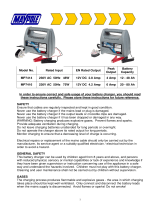Page is loading ...

RoHS
COMPLIANT
Lancashire
BL9 9NB
Streetwize Accessories:
Sales enquiries: [email protected]
Technical enquiries: [email protected]
www.streetwizeaccessories.com
6/12Volt 8Amp
Fully Automatic
Battery Charger
6. Battery charger is fused (2 spares included). The fuse will break and the charger will
be switched off upon - Short Circuit, Overload or Reverse Polarity. Simply change
the “blade” style fuse to restart charging.
7. To disconnect the battery when charged, switch off the mains supply and unplug.
Caution: Because of risk of explosive gas, only disconnect the crocodile clips when
the mains are disconnected. Check the fluid levels and top up if necessary and wipe
the battery clean. If the battery has been removed, replace in the vehicle and re-
connect.
Product Specifications:
Streetwize Part Number: SWBCLED8
Voltage Rating Input: 220V, 60Hz - 105W
Output Rating:
6/12V - HI:
5.6 ADC equal to 8Amps RMS
6V
- LOW: 2.5 ADC equal to 6Amps RMS
12V
- LOW: 3.5 ADC equal to 6Amps RMS
The WEEE symbol on this product means that this product should be ethically
dismantled or recycled to minimise environmental impact.
Please check with your local authority for more information.
IMPORTANT: ADDITIONAL SAFETY INFORMATION
This Battery Charger is NOT intended for use by persons (including children) with
reduced physical, sensory or mental capabilities, or lack of experience and knowledge,
unless they are supervised or have been given instruction concerning use of the Battery
Charger by a person responsible for their safety.
FOR INDOOR USE ONLY
Please read these instructions carefully before operating this battery charger.
Part No. Rated Output Battery Voltage Battery Capacity
SWBCLED8 8Amp 6/12 Volt 9-105 Ah
SWBCLED8
WARRANTY: To validate the warranty on this product, please go to our web site and
enter your details on the warranty screen. www.streetwizeaccessories.com.
SWBCLED8 Manual AW.qxp:Layout 1 5/1/16 13:29 Page 1

Battery Maintenance:
Please check your battery regularly throughout the year and especially in
the winter.
Faulty cells can cause problems with your battery, check the cells with a hydrometer, if
any cell is reading lower than the others it can indicate a faulty cell. If this is the case
have your battery checked, as you may need a new battery. It is possible that a battery
may appear flat when it could simply be a loose connection of the battery terminals.
Check the terminals and tighten if necessary then check the battery again.
To enable safe operation of this battery charger, make sure you follow basic safety
principles to reduce a risk of personal injury, electric shock and fire.
Always ensure the battery charger is kept in a dry place to avoid damage, and store out
of the reach of children. Do not use the charger in damp or wet areas as moisture will
damage the transformer.
Always check the battery chargers plug, cables and crocodile clips before use. Do not
open the charger, there are no serviceable parts.
When charging, the liquid in the battery may bubble causing a release of gas, this is
flammable so always operate the charger in a well ventilated place and away from
naked flames and sparks.
These chargers are only suitable for 6/12 Volt Lead-Acid batteries and should
not be used to recharge NICAD or any other type of battery.
DANGER: Avoid getting battery acid (electrolyte) on your skin or clothing, as it
may cause burns. If this occurs rinse immediately with cold water and if
necessary seek medical advice.
The charger contains a temperature-sensitive switch that automatically cuts off
when the charger is overloaded or becomes excessively hot. The charger will
switch back on after the unit has cooled.
Operating Instructions:
Please read the information on the front of these instructions for the maximum
battery capacity recommended for use with this charger. Using with batteries smaller
than this capacity may lead to damage to your battery.
1. Disconnect the Battery from the vehicle to avoid damage to the alternator. It is
advisable were possible to remove the battery from the vehicle as spillage from the
battery can cause damage.
Safety Instructions:
FOR INDOOR USE ONLY.
2. If you have a maintenance free/sealed battery it is not necessary to carry
out the following checks. Carefully remove all the caps from each battery cell,
and ensure the liquid as at the recommended level. Top up with distilled or de-
ionised water if required (ALWAYS wear protective gloves as this liquid is corrosive).
Tap water should NOT be used under any circumstances, allow time for any gases to
escape before replacing the caps. Warning: if your battery is the AUTOFIL type,
manufactured by Dagenite or Exide, the glass balls and the long filler cap MUST be
left in place during charging.
3. DO NOT plug the charger in until you have connected the crocodile clips correctly.
4. Connect the crocodile clips in the following order.
a) Connect positive (+ Red) charging lead to positive (+Red) terminal.
b) Connect negative (- Black) charging lead to negative (-Black) terminal.
It is important that the clips are making good contact with the battery terminals.
IMPORTANT OPERATING INFO:
5. Plug the Charger in using the fused AC mains plug, turn on the battery charger, the
RED LED should illuminate. Select the voltage of the battery you are charging 6v or
12v using the switch. Then select Hi (fast charging) or Low (slow charging). When
the 3 step charging process commences, the percentage LED’s will illuminate, as
the charging progresses until the battery reaches 100%, the time for this will vary
depending on the condition of the battery (around 4-6 hours approx).
The battery can remain connected at this point, sensors in the battery
charger AUTOMATICALLY switch the charger to a MAINTENANCE/TRICKLE
charge preventing over-charging. This will maintain the battery in a fully
charged condition for long periods.
SWBCLED8 Manual AW.qxp:Layout 1 5/1/16 13:29 Page 3
/








